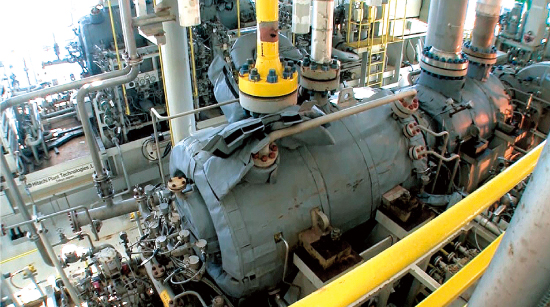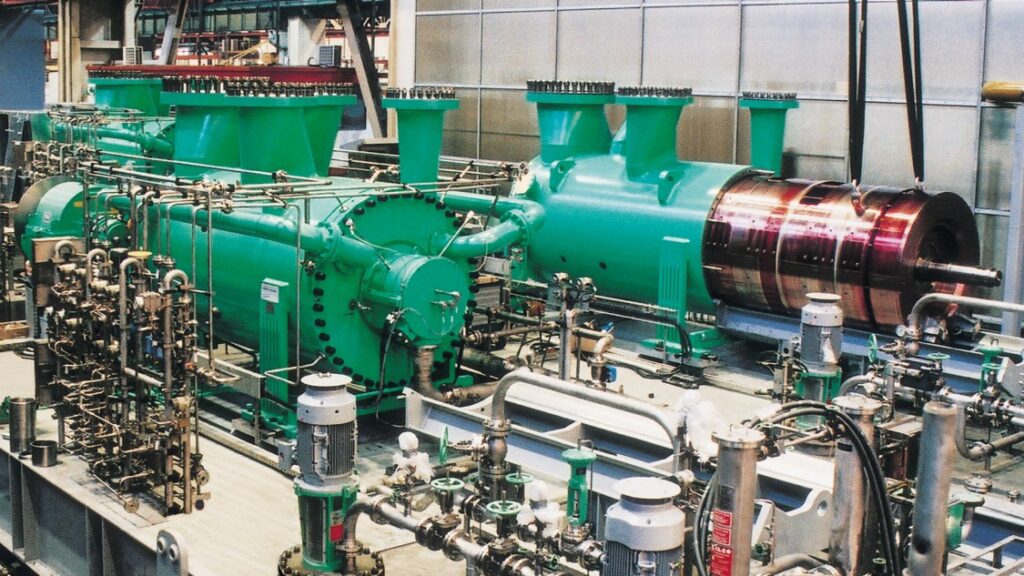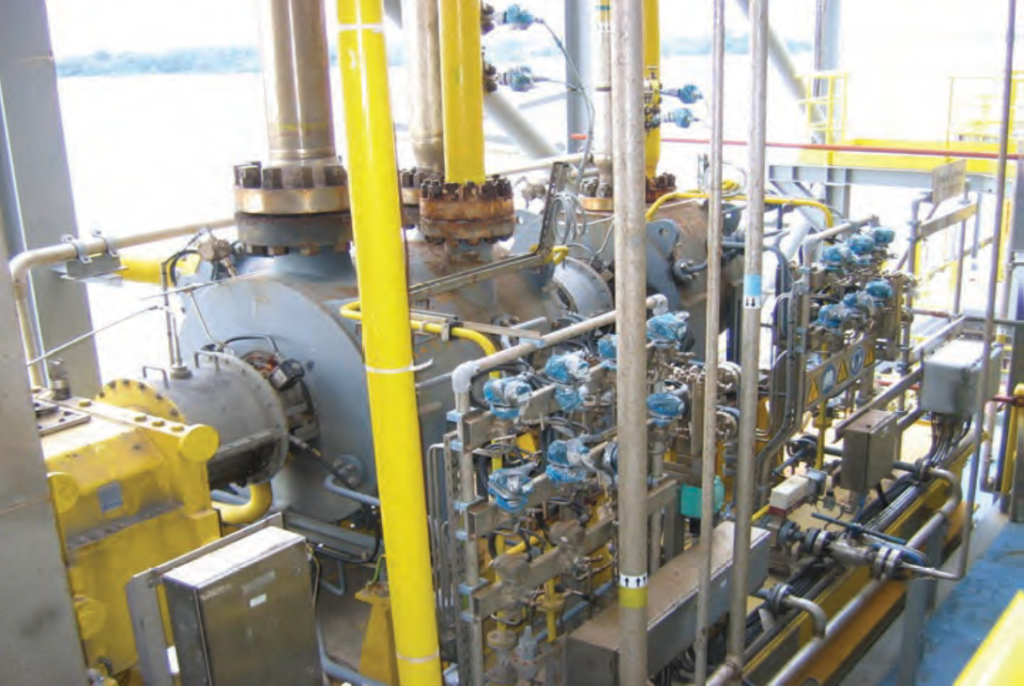RECENT ADVANCES IN TECHNOLOGY - 2 / CENTRIFUGAL COMPRESSORS

ANTI-SURGE CONTROL, MONITORING & PROTECTION SYSTEM
Anti-surge control, monitoring, and protection systems are crucial components in air and gas process systems, especially in centrifugal compressors. The primary function of these systems is to prevent compressor surging, which can cause severe damage to the compressor and other downstream equipment, leading to unexpected downtime and costly repairs.
Recent technology advancements in anti-surge systems have improved their effectiveness and reliability. One such technology is the use of advanced algorithms and artificial intelligence to provide better control of the compressor’s speed and flow rate. These systems can adapt to changes in process conditions in real-time, improving the compressor’s stability and efficiency while reducing the risk of surging.
Another technology is the use of advanced sensors and monitoring systems that provide real-time data on process conditions, compressor performance, and system behavior. This information can be used to identify potential issues before they cause equipment damage, allowing for proactive maintenance and reducing downtime.
Additionally, protective systems such as safety valves and pressure relief devices are important components of anti-surge systems. These devices provide a safety barrier that protects the compressor and downstream equipment in the event of an emergency or process upset.
In summary, anti-surge control, monitoring, and protection systems are critical in air and gas process systems. Recent advancements in technology have improved their effectiveness and reliability, reducing the risk of surging and ensuring safe and reliable compressor operation. It is important to consider these advancements when designing new systems or upgrading existing ones in the oil, gas, and petrochemical industries.
ADVANTAGES & DISADVANTAGES USING ANTI-SURGE CONTROL, MONITORING & PROTECTION SYSTEM
Advantages:
- Anti-surge control, monitoring, and protection systems can help prevent compressor surge and stall, which can lead to equipment damage and downtime.
- These systems can improve compressor efficiency by ensuring that the compressor is always operating within safe and optimal conditions.
- The use of advanced technology such as dynamic surge control can further enhance the protection and control of the compressor during transient conditions, such as changes in load or process conditions.
- Anti-surge control systems can also help reduce maintenance costs by preventing equipment damage and extending the life of the compressor.
Disadvantages:
- The installation and maintenance of anti-surge control systems can be expensive, especially for large compressors and complex process systems.
- The additional instrumentation required for the control and monitoring of the compressor can add complexity to the system, which may require additional training and resources for operation and maintenance.
- Anti-surge control systems can also introduce additional points of failure in the system, such as control valves or sensors, which may require additional redundancy and backup systems to ensure continued operation.
- Some anti-surge systems can also reduce the overall efficiency of the compressor, especially if they require a significant amount of power to operate.
Overall, the benefits of using anti-surge control, monitoring, and protection systems in air and gas processes outweigh the disadvantages, especially in industries such as oil, gas, and petrochemicals where downtime and equipment damage can result in significant financial losses.

LIMITS IN ENGINEERING & DESIGN FOR ANTI-SURGE CONTROL, MONITORING & PROTECTION SYSTEM
There are several limits in engineering and design when it comes to anti-surge control, monitoring, and protection systems for centrifugal compressors in air and gas processes. Some of these limits include:
Pressure and temperature limits: The anti-surge control system must be designed to operate within certain pressure and temperature limits. The compressor system must be designed to handle the maximum pressure and temperature that the system is expected to encounter during operation.
Surge margin: The anti-surge control system must be designed to maintain a surge margin, which is the difference between the operating point and the surge line on the compressor performance curve. The surge margin is critical to prevent compressor surge, which can lead to catastrophic failure.
Compressor speed: The anti-surge control system must be designed to handle changes in compressor speed. Compressor speed affects the compressor’s surge line and operating point, and the anti-surge control system must be able to adjust accordingly.
Flow rates: The anti-surge control system must be able to handle changes in flow rates. Changes in flow rates can affect the compressor’s surge line and operating point, and the anti-surge control system must be able to adjust accordingly.
Compatibility: The anti-surge control system must be compatible with the compressor and the rest of the system. The system must be designed to work with the specific compressor and must be integrated with the rest of the system to ensure optimal performance.
Maintenance and testing: The anti-surge control system must be designed to be easily maintained and tested. Regular maintenance and testing are critical to ensuring the system is working properly and preventing catastrophic failures.
Overall, the engineering and design of anti-surge control, monitoring, and protection systems for centrifugal compressors in air and gas processes must take into account these limits to ensure optimal performance, reliability, maintainability, and safety.
WHY, WHERE, WHEN TO USE ANTI-SURGE CONTROL, MONITORING & PROTECTION SYSTEM
Anti-surge control, monitoring, and protection systems are essential in air and gas processes that involve centrifugal compressors, particularly in the oil, gas, and petrochemical industries. These systems are used to ensure that the compressor operates within a safe operating range and to prevent surging, which can lead to critical failures or highly costly shutdowns.
Surging occurs when the flow through the compressor becomes unstable, causing pressure fluctuations and reducing the efficiency of the compressor. In severe cases, surging can cause damage to the compressor and other components of the system. Anti-surge control systems work by monitoring the flow, pressure, and other parameters of the compressor and adjusting the operating conditions to prevent surging.
New technologies are continually being developed to improve the reliability, maintainability, and safety of anti-surge control systems. For example, advanced sensors and control algorithms can improve the accuracy and responsiveness of the system, while remote monitoring and predictive maintenance can help to detect potential issues before they become critical.
The use of anti-surge control, monitoring, and protection systems is particularly critical in high-pressure and high-temperature applications, such as gas pipelines and refining processes. They are also essential for new projects that require reliable and safe operation of centrifugal compressors.
Overall, the use of anti-surge control, monitoring, and protection systems is necessary to ensure safe and reliable operation of centrifugal compressors in the oil, gas, and petrochemical industries. It helps to avoid critical failures, unscheduled shutdowns, and costly repairs, which can have significant economic and environmental impacts.

PROCEDURES, ACTIONS, STUDIES, MITIGATION, RECOMMENDATIONS USING ANTI-SURGE CONTROL, MONITORING & PROTECTION SYSTEM
Here are some procedures, actions, studies, mitigation, and recommendations to consider when implementing anti-surge control, monitoring & protection systems in air and gas processes using the latest technology available for centrifugal compressors:
Conduct a thorough analysis of the process conditions, gas composition, and equipment specifications to determine the most suitable anti-surge control and protection system.
Perform a comprehensive risk assessment to identify potential failure modes, consequences, and criticality levels. This should be done during the design stage and reviewed periodically during the operational life of the system.
Select the most appropriate anti-surge control and protection system, considering factors such as process flow, pressure and temperature ranges, control accuracy, and system response time.
Install and commission the anti-surge control and protection system, ensuring that it is properly integrated into the process control system.
Provide adequate training for personnel responsible for operating and maintaining the system, including emergency response procedures.
Develop a maintenance and inspection program to ensure the system is operating within acceptable limits and to detect any potential issues before they become critical.
Use advanced monitoring technologies such as vibration analysis, thermography, and acoustic emissions to detect and diagnose equipment faults and anomalies.
Implement continuous improvement initiatives to optimize the performance of the anti-surge control and protection system, including system tuning and optimization, software updates, and hardware upgrades.
Keep up-to-date with the latest advancements in anti-surge control and protection technologies to ensure that the system remains effective and reliable over the long term.
By following these procedures, actions, studies, mitigation, and recommendations, it is possible to improve the reliability, maintainability, safety, and availability of air and gas process systems using centrifugal compressors while avoiding critical failures or costly shutdowns.
CRITICAL RISKS USING ANTI-SURGE CONTROL, MONITORING & PROTECTION SYSTEM
There are several critical risks associated with using anti-surge control, monitoring, and protection systems in air and gas processes with centrifugal compressors. Some of these risks include:
Failure of the anti-surge system: If the anti-surge system fails, it can result in a surge condition that can cause severe damage to the compressor and other equipment downstream. To mitigate this risk, regular maintenance, testing, and monitoring of the system should be conducted.
Inaccurate process data: If the data used by the anti-surge system is inaccurate, it can cause the system to activate unnecessarily or fail to activate when required, leading to potential surge conditions. Ensuring accurate and reliable process data is critical to the proper functioning of the system.
Inadequate protection systems: Inadequate protection systems can result in compressor damage or catastrophic failure. It is essential to have adequate safety measures in place, such as emergency shutdown systems, pressure relief valves, and fire protection systems.
Electrical and control system failure: Electrical and control system failures can lead to compressor shutdowns, surge conditions, and potentially catastrophic failures. Regular inspections, testing, and maintenance of electrical and control systems can help mitigate this risk.
Lack of training and competency: The proper operation and maintenance of anti-surge control, monitoring, and protection systems require skilled personnel with specialized training and expertise. Lack of training and competency can result in errors or omissions that can lead to system failures or improper operation.
To mitigate these critical risks, it is recommended to implement a robust risk management plan that includes regular maintenance, testing, and monitoring of the anti-surge system, as well as adequate safety measures, competent personnel, and reliable process data. It is also essential to stay up to date with the latest technology and best practices to continuously improve the reliability, maintainability, and safety of the system.
